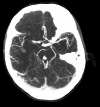Recurrent Systemic Embolization From Bicuspid Aortic Valve Endocarditis in the Setting of Anti-coagulation Use
- PMID: 39651010
- PMCID: PMC11624488
- DOI: 10.7759/cureus.73187
Recurrent Systemic Embolization From Bicuspid Aortic Valve Endocarditis in the Setting of Anti-coagulation Use
Abstract
Infective endocarditis (IE) is a systemic disease with a high mortality rate even with intravenous antibiotic therapy. Abnormal valves, including bicuspid aortic valves (BAV), are particularly prone to it compared to normal valves. We present a 22-year-old female who was initially admitted for the management of acute splenic infarction when she was diagnosed with a bicuspid aortic valve. With no evidence of a cardiac source of the embolus, she was discharged on anti-coagulation. However, she returned with acute toe ischemia in a few days. She was found to have Streptococcus mitis bacteremia, multiple sub-centimeter aortic valve vegetations on trans-esophageal echocardiogram (TEE), and was subsequently diagnosed with IE. After 3 weeks of IV antibiotics, she presented with thalamic stroke. Our case underscores the challenges in managing IE, particularly in young patients with BAV. Early recognition and aggressive treatment, regardless of vegetation size, and avoidance of anti-coagulation are crucial to mitigate embolic complications.
Keywords: antibiotics therapy; bicuspid aortic valve disease; infective endocarditis; intraoperative/postoperative anticoagulation; septic emboli; surgical replacement of valve.
Copyright © 2024, Rafique et al.
Conflict of interest statement
Human subjects: Consent for treatment and open access publication was obtained or waived by all participants in this study. Conflicts of interest: In compliance with the ICMJE uniform disclosure form, all authors declare the following: Payment/services info: All authors have declared that no financial support was received from any organization for the submitted work. Financial relationships: All authors have declared that they have no financial relationships at present or within the previous three years with any organizations that might have an interest in the submitted work. Other relationships: All authors have declared that there are no other relationships or activities that could appear to have influenced the submitted work.
Figures







Similar articles
-
Infective Endocarditis in Patients With Bicuspid Aortic Valves: Unique Clinical and Microbiologic Features.Heart Lung Circ. 2024 Oct;33(10):1484-1491. doi: 10.1016/j.hlc.2024.02.023. Epub 2024 Aug 16. Heart Lung Circ. 2024. PMID: 39153949
-
Aortic valve endocarditis in patients with bicuspid and tricuspid aortic valves.JTCVS Open. 2021 Sep 15;8:228-236. doi: 10.1016/j.xjon.2021.09.007. eCollection 2021 Dec. JTCVS Open. 2021. PMID: 36004079 Free PMC article.
-
Infective endocarditis in patients with bicuspid aortic valve: Clinical characteristics, complications, and prognosis.Enferm Infecc Microbiol Clin. 2017 Dec;35(10):645-650. doi: 10.1016/j.eimc.2016.06.017. Epub 2016 Aug 1. Enferm Infecc Microbiol Clin. 2017. PMID: 27493083 English, Spanish.
-
Native-valve Enterococcus hirae endocarditis: a case report and review of the literature.BMC Infect Dis. 2019 Oct 24;19(1):891. doi: 10.1186/s12879-019-4532-z. BMC Infect Dis. 2019. PMID: 31651255 Free PMC article. Review.
-
Infective Endocarditis Following Aortic Valve Replacement: A Systematic Review.Cureus. 2023 Nov 19;15(11):e49048. doi: 10.7759/cureus.49048. eCollection 2023 Nov. Cureus. 2023. PMID: 38116334 Free PMC article. Review.
References
-
- Bicuspid aortic valve disease with early onset complications: Characteristics and aortic outcomes [PREPRINT] Selbst MA, Laughlin MK, Ward CR, et al. medRxiv. 2024
-
- The bicuspid aortic valve: adverse outcomes from infancy to old age. Lewin MB, Otto CM. Circulation. 2005;111:832–834. - PubMed
Publication types
LinkOut - more resources
Full Text Sources
